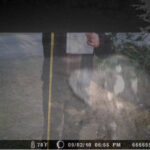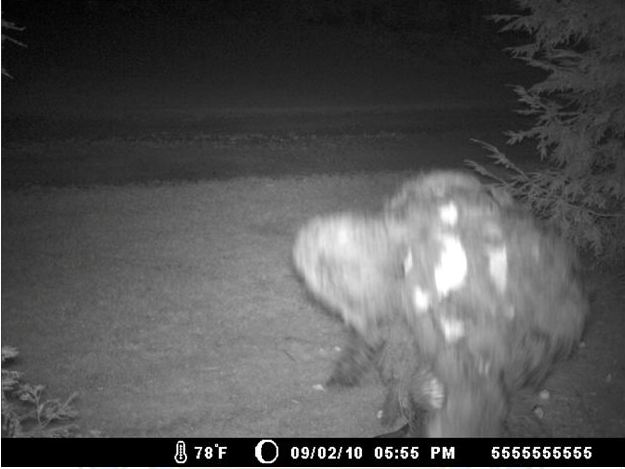The Vermont Trail Camera photo was obtained on September 3, 2010 by a man named Frank (last name withheld). Frank and his wife live on a rural property in western Vermont. They own several acres backed up against large expanses of privately owned forest. On their property, there are eighteen fruit trees specifically planted and maintained to bring in wildlife for Frank’s and his wife’s viewing pleasure. In their front yard is a decent sized pond which contains numerous trout, and just down the road from the property is another even larger pond several acres in size. The surrounding hills are steep and thickly wooded making the area excellent habitat for all sorts of creatures. On top of it all, the area has a history of bigfoot activity as well. Several years before the photograph was obtained, one of Frank’s neighbors reported seeing a sasquatch down the road from Frank’s property.
Frank’s wife remembers hearing strange noises in the woods the week that this photograph was obtained. Those noises included banging and strange vocalizations. After obtaining the photo, Frank asked the Vermont Fish and Wildlife Department what is in the photograph. They didn’t know, but suggested it was an owl. Thinking this was a ludicrous explanation, Frank later went to Steve Kulls, a New York-based bigfoot researcher who did his own investigation into the photograph. Steve’s excellent analysis of the photo, as well as other background information on the picture, can be found here.
I spent several hours with Frank and his wife talking about the photographs and the surrounding area. I am utterly satisfied that Frank is not lying about the photographs or the circumstances surrounding them in any way.
One evening in August of 2010, Frank noticed that an apple tree near his driveway had a large circular perhaps five feet in diameter utterly devoid of fruit. The fruit was missing higher off the ground than seemed normal, which puzzled Frank. He decided to deploy a game camera to see what kind of creature was stealing his apples.
Over the next couple days, the camera recorded images of a coyote that returned on two consecutive nights to eat some apples that had fallen on the ground nearby. Around midnight on September 3rd, the camera took a photograph of what appears to be a sasquatch bending down in a squatting fashion and reaching towards the ground with its left arm. The creature’s head is to the left of the photograph, and its butt is sticking out to the right (complete with a hint of the natal cleft) with its legs bending below it, though the knee is obscured by the creature’s left arm. One can, however, make out the creature’s left calf at the very bottom of the picture.
The creature appears to be fairly light in color, but the actual color is uncertain due to the fact that the flash the camera used was infrared. Infrared light interacts with fabrics and surfaces differently than visible light, and often distorts colors making them lighter or darker in appearance than they actually are. For example, a black jacket could look very light in color when seen under an infrared illuminator. I bring this up because no matter what color the creature actually is, there appears to be a mass of fur underneath the creature near its chest that is of a distinctly darker color than the rest of it. The darker fur extends onto the creatures left arm and appears to end in what I interpret as knuckles or a clenched hand. I hypothesize that the darker fur is a juvenile sasquatch clinging onto the larger creature’s chest. This is the standard way all apes, including humans, carry their infants. If this is true, then this photograph shows two sasquatches, an assumed female and its young.
The creature appears to have white splotches on its back. I have no idea what these are, but several ideas have been put forth. One possibility is that the creature has a skin condition called vitiligo. Vitiligo is a depigmentation of the skin, usually in patches, that affects less than 1% of the human population. It is well known that humans and apes can often are susceptible to the same conditions and ailments, including heart disease, pneumonia, and many others. I see no reason why vitiligo would not occasionally show up in the sasquatch population, especially if they are closely related to humans as some speculate. Of course, these splotches might be something else besides vitiligo, but this diagnosis is at least possible.
When one considers these white splotches, it seems less likely that this is a human in a suit. Remember the point above about how infrared light can make different fabrics or surfaces appear darker or lighter than they actually are. If this is a person in a suit, those patches would represent different kinds of material that make up the suit. However, they are abnormally shaped, irregular in placement, and are not on where connections or seams would be in a suit. Why would someone make a suit and randomly place different fabrics on the shoulders and the back? There would be no function to this. Indeed, why would a hoaxer make a suit with these white patches at all?
The recreation that was done on Finding Bigfoot was brief and not as in-depth as I wanted, so I found time to return to the site to do my own analysis. One of the things we do not know about the photographs is how far away the creature was from the camera. Since this variable is pretty important if we want to compare the creature’s size to a known size, I decided to take numerous photos using the same game camera, but all from different distances. I felt this would give me a range in possible sizes of the creature. The first comparison photograph was taken at just four feet from the camera, which is obviously much closer to the camera than the creature was. I then took photographs at distances that increased by one foot per photo all the way out to nine feet from the camera.
Frank knew exactly where he placed the camera, and in fact had a wooden marker on the tree. This enabled me to put the camera right where I needed it. Since Frank wedged a piece of wood behind the camera to prop it up to the right angle, this was the only real variable in the camera’s placement. I compensated for this by simply superimposing my comparison shots over the original photograph and lining up the road in both pictures since it is static in location.
In my comparison shots, I held a notebook showing my distance from the camera, as well as a tape measure that was extended to the ground. Using the superimposed photographs, I then took measurements of the shoulder height at the left, right, and center for each of the various distances. Below is that information. All measurements were taken in inches. The angle of view of the camera makes these heights approximations instead of exact measurements, but that’s sometimes the best we can hope for.
| Distance from camera in inches (feet) | Left Shoulder | Center Shoulder | Right Shoulder |
| 48 (4 ft) | 46 | 50 | 54 |
| 60 (5 ft) | 43 | 47 | 51 |
| 72 (6 ft) | 38 | 44 | 49 |
| 84 (7 ft) | 35 | 42 | 47 |
| 96 (8 ft) | 32 | 38 | 44 |
| 108 (9 ft) | 22 | 31 | 38 |
By looking at how the photographs line up with me in the pictures, I think the best estimate on the real distance from the camera to the creature is somewhere between seven and eight feet (84 and 96 inches). To me it appears that seven feet is a little too close, and eight feet is a bit too far. By using an average of the two distances, we come up with a center shoulder height of 40 inches. When I put myself in the same position as the creature, my center shoulder measurement is about 36 inches high. This seems to indicate that the creature is not really all that big. Bigger than me, but certainly not an eight-footer. Of course, it’s pretty well established that the species shows a sexual dimorphism (meaning that males are bigger than females), just as the other ape species do (including humans). The typical female sasquatch may only be six or seven feet tall on average. The exact number is unknown, of course, but most estimates fall somewhere in this range.
By using the superimposed photograph taken at eight feet (which to me seems a bit closer to the sasquatch’s actual position than seven feet does), I can determine some other measurements of the creature by counting pixels in the photograph, converting them into real lengths, and playing around with some ratios. For example, from the crown of the head to the top of the shoulders measures about 13 inches. I have to wonder if this would be the full head of the creature, though. It’s possible that the bigfoot’s chin is lower than the shoulder height. The width of the arm right below the shoulder in the area of the bicep measures a staggering 9.3 inches across, nearly twice that of my own despite our similarities in size. The length of the upper segment of the leg from the bend in the knee to the bottom of the buttocks is about 14.5 inches in length. What I interpret as being the juvenile’s hand is 3.4 inches wide, virtually identical to my own hand without the thumb.
The arguments that this shows anything but a bigfoot or a human in a suit seem very unlikely to me. If it is a human in a suit, then this is the only photograph of the suit in existence, and it’s likely that a hoaxer who spent his or her time, money, and effort to make such a suit would eventually want to use it again. The size of the figure is certainly within the human range, but many sasquatches are also in that same size range. If it is a hoax, then the perpetrator not only went out of his or her way to introduce anomalies, such as the possible vitiligo, but also created a juvenile hanging on the front in a decidedly ape-like fashion. The hoaxer also trespassed onto a private property that has dogs that bark at the presence of intruders, a security system, and an armed owner. Frank’s neighbors would not have hoaxed him. Frank did not announce the presence of the trail camera, so how would the hoaxer know when and where to appear to get captured on film? I think a hoax is very unlikely.
While this photograph is in no way proof that bigfoots are real, it is evidence thereof. I strongly suspect that this is a real picture of a sasquatch living somewhere near the Vermont and New York border.
The slideshow below shows my comparison photographs taken with the same trail camera superimposed over the original photo. These photos also give an interesting perspective on how the creature’s size compares to my own.








